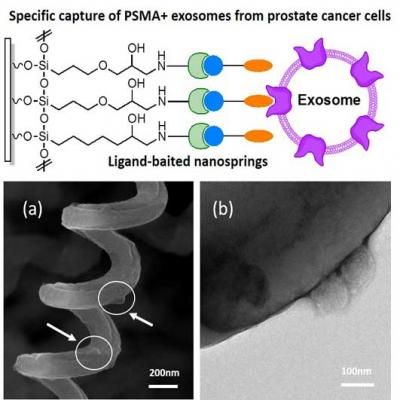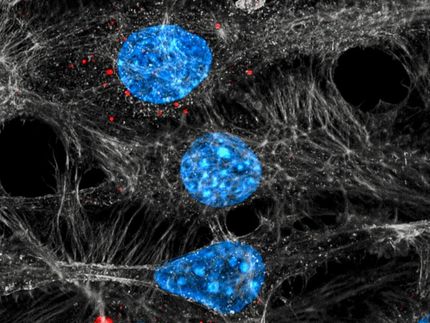New approach for the capture of tumor-derived exosomes from a prostate cancer cell line
Advertisement
Researchers at Washington State University report a new approach for the effective capture of tumor-derived exosomes from a prostate cancer cell line. Exosomes are small secreted vesicles that play a key role in intercellular communication and cancer progression.

Figure a shows captured exosomes on ligand-baited nanosprings, the exosomes are indicated by the arrows. Figure b shows a TEM image of captured exosomes following negative staining with phosphotungstic acid (PTA) PH = 7.1.
Springer Science+Business Media New York 2017
Developing effective and high-throughput selective capture technology for exosomes bearing the prostate-specific membrane antigen (PSMA) biomarker is critical for early diagnostic and prognostic evaluation of prostate cancer and treatment planning. It is known that the prostate tumor enzyme-biomarker PSMA is highly enriched in exosomes secreted by PSMA+ prostate cancer cells. A novel biofunctionalized silica nanostructure was designed to selectivity capture tumor-derived exosomes through the interaction of a known PSMA ligand with the PSMA on the exosomes.
This work enables a non-invasive approach for diagnosis and prognosis of prostate cancer. It overcomes many of the limitations of alternative approaches that are often ineffective in isolating tumor-derived exosomes from those derived from normal tissue because of the low recovery yields and the time required for the process.
The concept was demonstrated using a single cancer type (i.e., prostate cancer), but based on the data presented in this study, the authors expect that a broad panel of biomarker ligands can be baited on the silica nanostructures to selectively capture biomarker-positive exosomes from an array of cell types. Further advantages of the approach used in this study are the ability to isolate a specific subpopulation of exosomes relying on the expression of a specific surface marker as well as improved exosome recovery rate. In the future, the authors envision a microfluidic flow device that will allow for increased exosome capture efficiency and clinical applications.






















































